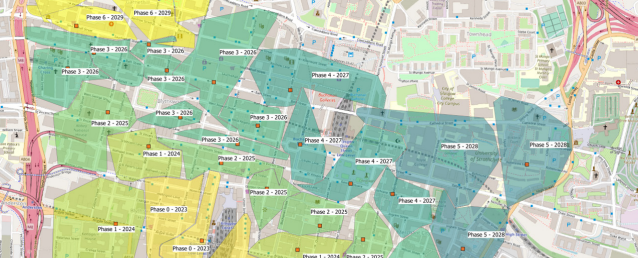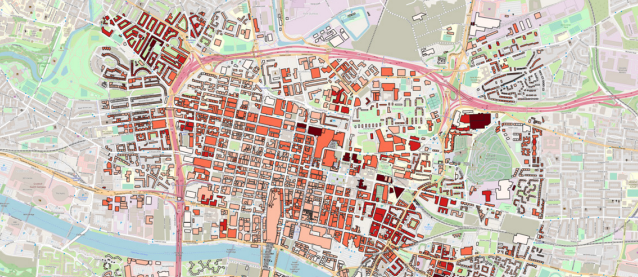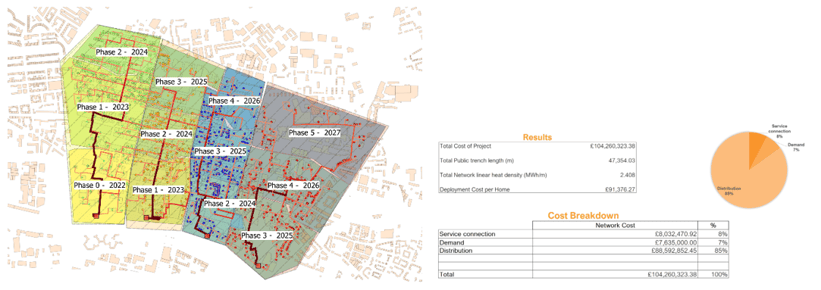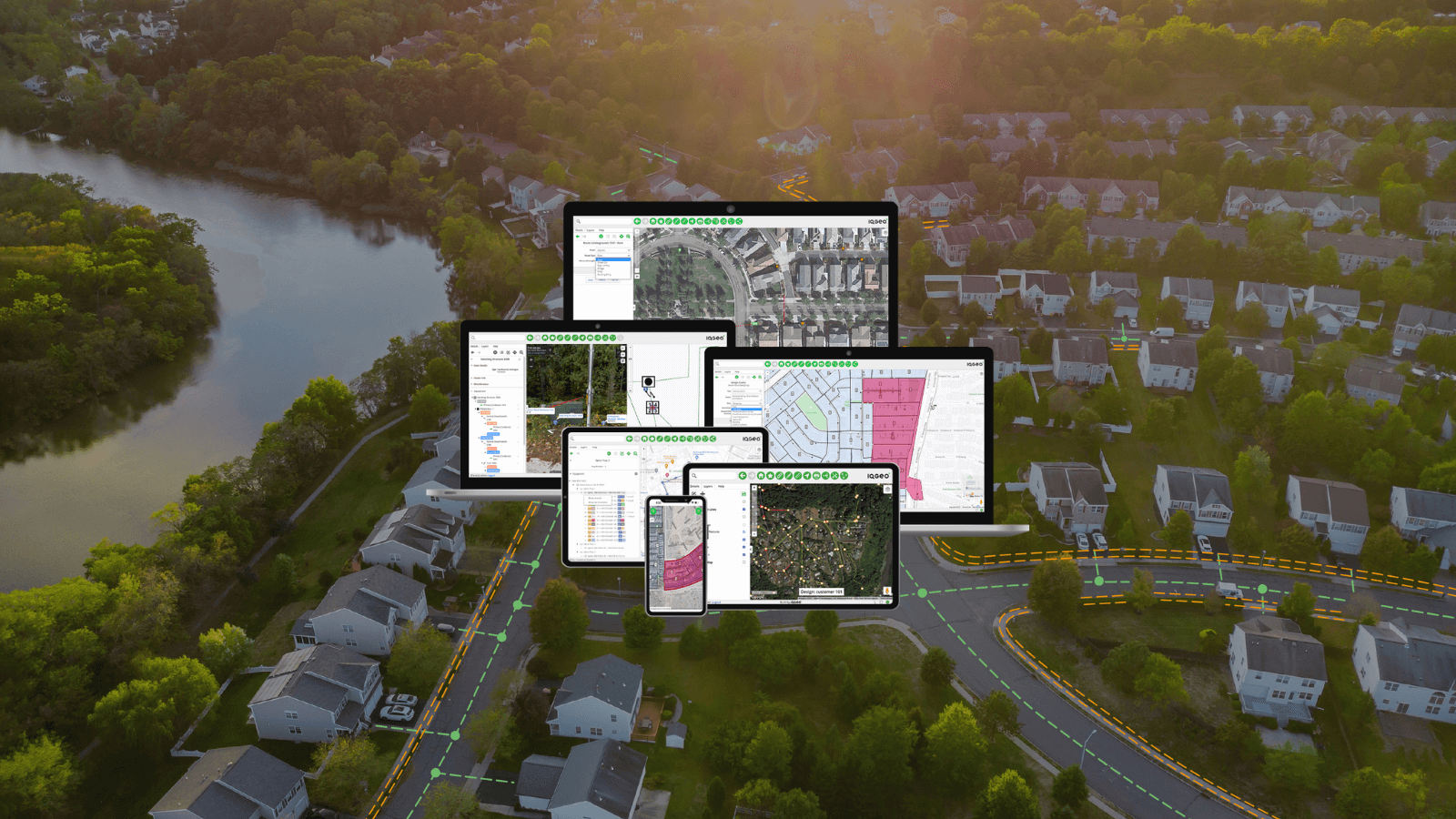Discover how IQGeo’s Comsof Heat software can optimize district network planning and support heat network zoning strategies.
Understanding the importance of district heating network planning
District network planning plays a crucial role in the efficient and effective distribution of heat. By carefully planning the layout and design of heat networks, engineering firms and consultancies can ensure that energy is distributed in the most optimal way, minimizing heat loss and maximizing the reach of the network. This is essential in achieving sustainable and cost-effective heat solutions for communities and buildings.
Effective district network planning also considers factors such as demand patterns, existing infrastructure, and future growth projections. By understanding these factors, consultancies can develop heat network zoning strategies intended to support the development of district heating networks and that meet the specific needs of each area, ensuring that the network is scalable and adaptable to changing demands.
With the support of IQGeo’s GIS-based district heating software, engineering companies and consultancies can streamline their district network planning processes and make informed decisions based on accurate data, enabling them to design heat networks that are not only efficient but also resilient.
Transforming district heat planning and design with Comsof Heat
IQGeo’s Comsof Heat software is an innovative solution that transforms the way engineering firms and consultancies plan, design and optimize district energy networks. This industry-leading software challenges traditional methods, eliminating manual calculations and siloed data in favor of a holistic, data-driven approach. It combines advanced algorithms, GIS technology, and thermodynamics to provide accurate and comprehensive insights into heat network planning.
Planners have the ability to analyze various factors such as building heat demand, heat sources, network topology, pressure and flow constraints to create customized heat network designs. The software enables them to visualize and simulate different scenarios, allowing for data-driven decision-making and optimization. The advanced algorithms automate complex calculations, generates a bill of materials, creates accurate, real-life feasibility studies and assesses optimal regions to target for district heating, enabling engineering firms and consultancies to streamline processes, enhance efficiency, and design sustainable and cost-effective heat networks.
Enhancing efficiency with automated planning
One of the key advantages of using the software is its ability to automate the district heat planning process. Traditional manual planning methods often involve time-consuming tasks such as data collection, analysis, and design iterations, but by automating calculations and generating optimized heat network designs, significantly reduces the time and effort required for manual planning processes.
By automating the planning process, planners can quickly assess the feasibility of different network configurations, analyze the impact of design changes, and identify the most cost-effective solutions. They can explore multiple scenarios, considering different constraints and objectives, to find the most optimal heat network configuration. This not only enhances efficiency but also improves the accuracy and reliability of heat network planning. This flexibility allows them to adapt to changes in demand, infrastructure, and other factors, ensuring that the heat network remains efficient and future-proof.
Example from Glasgow City Heat Network feasibility study: Displaying how each section of the city will be integrated onto the district heat network using Comsof Heat.
Streamlining district heating network design and optimization
Comsof Heat integrates with GIS data, allowing the overlay of heat demand, existing infrastructure, and other relevant information on a map. With a visual map of the heat network, planners can identify potential optimization opportunities and make informed decisions regarding network expansion, routing, and capacity planning. They can assess the impact of different design choices and evaluate the feasibility of integrating renewable energy sources into the network, helping build the strongest possible business case.
The software also offers advanced optimization algorithms that help engineering consultancies find the most cost-effective solutions. By considering factors such as energy efficiency, heat losses, and investment costs, the software generates optimized network designs that maximize performance while minimizing expenses, to create efficient and sustainable heat networks that meet the unique requirements of each area.
“We had a very technical result it gave lots of interesting input. For example, we might need 900-1.300 garage sized locations in existing neighborhoods for district heating equipment, or 2.100 km piping through existing streets, or 1.000 km streets need to be opened. What is clear from the exploration, is the correlation between spatial impact, investment cost and energy performance, the scope of the problem is now clearer.” Tim Ruijs, Urban Planner and Designer with Amsterdam City
Example from Glasgow City Heat Network feasibility study: Using Hotmaps we overlay the heat demand density (HDD) over the selected area within Comsof Heat.
How does Comsof Heat support Heat Network Zoning strategies
The approach offers significant advantages in the development and optimization of the initial zoning opportunity's (IZO’s), providing a consistent level of detail, accuracy, and quality output over all IZO’s, underpinning the requirements to implement a standardized heat network zoning methodology.
Using an automated routing, dimensioning, and planning tool permits an integrated solution where the geospatial model, the technical model and the financial model are tightly interconnected and integrated within a GIS application. This enables a consistent and precise estimation of the required heat capacity and distribution infrastructure, minimizing the risk of overinvestment or underestimation.
By evaluating these parameters in a holistic manner, planners can make informed refinements that maximize cost-effectiveness and long-term sustainability within the constraints of the local considerations. Comsof Heat enables them to simulate and evaluate the performance of various zoning configurations, considering factors such as energy efficiency, cost-effectiveness, and environmental impact. This empowers consultancies to make informed decisions and select the most suitable zoning strategies for their projects, facilitating the identification of the most efficient and environmentally friendly options.
Recently, the Department for Energy Security & Net Zero (DESNZ) has released a tender for Heat Network Zoning in the UK, and IQGeo is well-equipped to assist consultancies with the Comsof Heat software. By utilizing this software, consultancies can enhance the accuracy of their cost estimation, develop efficient heat zoning strategies, automate planning processes, and optimize network designs for their projects.
Example from Glasgow City Heat Network feasibility study: Using an automated heat network routing tool like Comsof Heat ensures accurate, consistent and detailed technical and financial modelling.
Download the Heat Vision 2030: A District Heat Network for Glasgow white paper to explore the challenges and opportunities associated with deploying city-centre heat networks in the UK. This study delves into the methodology used to assess the feasibility of large-scale urban district heating leveraging Comsof Heat.
Why partner with IQGeo on your district energy projects
IQGeo’s GIS-based, automated planning and design software serves as a catalyst for the creation of environmentally responsible district energy networks. With the advanced capabilities of Comsof Heat, energy planners can delve deep into the analysis of heat demand patterns, existing infrastructure, and future growth projections within a specific zone. This invaluable insight allows engineering firms and consultancies to develop data-driven heat network zoning strategies and design heat networks that are perfectly tailored to the unique characteristics and needs of each area, ensuring the efficient distribution of heat and can confidently generate accurate and reliable long-term financial projections for their district energy projects.
“Thanks to the software, you know exactly how long the network is going to be. You end up with an optimal result, which saves costs. In addition, we optimize our own time. And if we need assistance, the support team is there for us.” Mark Van Oostende, Pipelines Advisor at Royal HaskoningDHV
Our dedicated district energy experts are fully committed to your success, offering ongoing optimization, guidance, and collaboration throughout your project's lifecycle. We go beyond being software providers; we are trusted advisors seamlessly integrated into your workflow, ensuring the successful implementation of your district energy projects.
Talk to our industry experts to see how our software can help with your district energy projects and Net Zero objectives.

Former Product Manager at IQGeo
Similar articles:






 Previous
Previous







